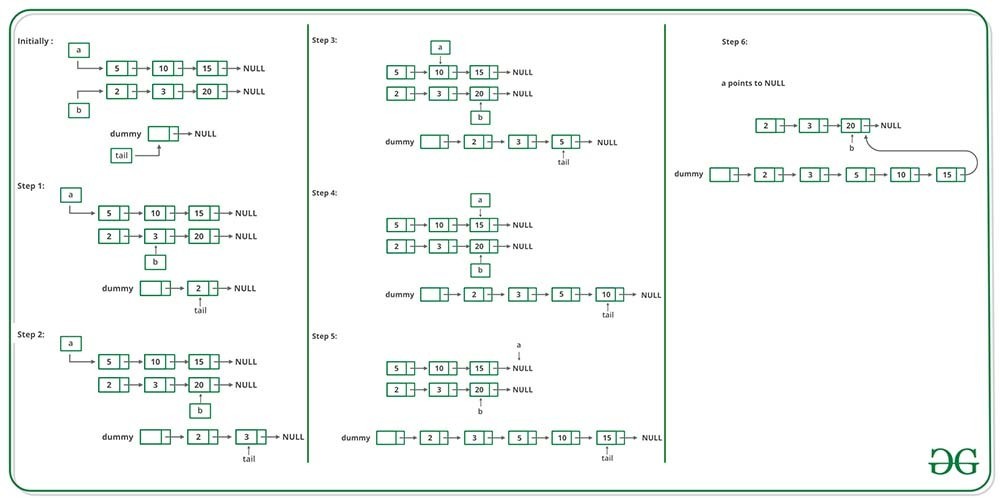Đề bài: Cho hai danh sách đã được sắp xếp gồm N và M nút tương ứng. Nhiệm vụ của bạn là kết hợp hai danh sách lại với nhau và trả về danh sách đã kết hợp theo thứ tự chuẩn.
Ví dụ:
Input: a: 5->10->15, b: 2->3->20
Output: 2->3->5->10->15->20
Input: a: 1->1, b: 2->4
Output: 1->1->2->4Trong bài viết này, Quản Trị Mạng sẽ cùng các bạn tìm hiểu cách viết chương trình kết hợp hai danh sách đã được sắp xếp bằng Python và C++.
Cách 1: Sử dụng các nút giả
Ý tưởng của phương pháp này là sử dụng một nút giả tạm thời làm nút đầu tiên của danh sách kết quả. Con trỏ Tail luôn luôn trỏ tới nút cuối cùng trong danh sách kết quả nên vì thế việc thêm các nút mới trở nên dễ dàng hơn nhiều.
Bạn có thể xem lược đồ bên dưới để có thể dễ hình dung hơn:

Làm theo các bước sau để giải quyết vấn đề:
- Đầu tiên, tạo ra một nút giả cho danh sách kết quả hợp nhất.
- Bây giờ, tạo ra hai con trỏ, một con trỏ sẽ trỏ vào danh sách 1 (list1) và con trỏ còn lại trỏ vào danh sách 2 (list2).
- Bây giờ, duyệt qua cả hai danh sách cho tới khi chúng hết mọi nút.
- Nếu giá trị của một nút đang được trỏ đến trong một danh sách nhỏ hơn giá trị đang được trỏ trong danh sách kia, thêm nút đó vào danh sách kết quả hợp nhất và tăng con trỏ đó lên.
Dưới đây là code mẫu bằng ngôn ngữ Python để các bạn tham khảo:
""" Python program to merge two
sorted linked lists """
# Linked List Node
class Node:
def __init__(self, data):
self.data = data
self.next = None
# Create & Handle List operations
class LinkedList:
def __init__(self):
self.head = None
# Method to display the list
def printList(self):
temp = self.head
while temp:
print(temp.data, end=" ")
temp = temp.next
# Method to add element to list
def addToList(self, newData):
newNode = Node(newData)
if self.head is None:
self.head = newNode
return
last = self.head
while last.next:
last = last.next
last.next = newNode
# Function to merge the lists
# Takes two lists which are sorted
# joins them to get a single sorted list
def mergeLists(headA, headB):
# A dummy node to store the result
dummyNode = Node(0)
# Tail stores the last node
tail = dummyNode
while True:
# If any of the list gets completely empty
# directly join all the elements of the other list
if headA is None:
tail.next = headB
break
if headB is None:
tail.next = headA
break
# Compare the data of the lists and whichever is smaller is
# appended to the last of the merged list and the head is changed
if headA.data <= headB.data:
tail.next = headA
headA = headA.next
else:
tail.next = headB
headB = headB.next
# Advance the tail
tail = tail.next
# Returns the head of the merged list
return dummyNode.next
# Create 2 lists
listA = LinkedList()
listB = LinkedList()
# Add elements to the list in sorted order
listA.addToList(5)
listA.addToList(10)
listA.addToList(15)
listB.addToList(2)
listB.addToList(3)
listB.addToList(20)
# Call the merge function
listA.head = mergeLists(listA.head, listB.head)
# Display merged list
print("Danh sách sau khi kết hợp là:")
listA.printList()
""" This code is contributed
by Debidutta Rath """Code mẫu bằng C++:
/* C++ program to merge two sorted linked lists */
#include <bits/stdc++.h>
using namespace std;
/* Link list node */
class Node {
public:
int data;
Node* next;
};
/* pull off the front node of
the source and put it in dest */
void MoveNode(Node** destRef, Node** sourceRef);
/* Takes two lists sorted in increasing
order, and splices their nodes together
to make one big sorted list which
is returned. */
Node* SortedMerge(Node* a, Node* b)
{
/* a dummy first node to hang the result on */
Node dummy;
/* tail points to the last result node */
Node* tail = &dummy;
/* so tail->next is the place to
add new nodes to the result. */
dummy.next = NULL;
while (1) {
if (a == NULL) {
/* if either list runs out, use the
other list */
tail->next = b;
break;
}
else if (b == NULL) {
tail->next = a;
break;
}
if (a->data <= b->data)
MoveNode(&(tail->next), &a);
else
MoveNode(&(tail->next), &b);
tail = tail->next;
}
return (dummy.next);
}
/* UTILITY FUNCTIONS */
/* MoveNode() function takes the
node from the front of the source,
and move it to the front of the dest.
It is an error to call this with the
source list empty.
Before calling MoveNode():
source == {1, 2, 3}
dest == {1, 2, 3}
After calling MoveNode():
source == {2, 3}
dest == {1, 1, 2, 3} */
void MoveNode(Node** destRef, Node** sourceRef)
{
/* the front source node */
Node* newNode = *sourceRef;
assert(newNode != NULL);
/* Advance the source pointer */
*sourceRef = newNode->next;
/* Link the old dest off the new node */
newNode->next = *destRef;
/* Move dest to point to the new node */
*destRef = newNode;
}
/* Function to insert a node at
the beginning of the linked list */
void push(Node** head_ref, int new_data)
{
/* allocate node */
Node* new_node = new Node();
/* put in the data */
new_node->data = new_data;
/* link the old list off the new node */
new_node->next = (*head_ref);
/* move the head to point to the new node */
(*head_ref) = new_node;
}
/* Function to print nodes in a given linked list */
void printList(Node* node)
{
while (node != NULL) {
cout << node->data << " ";
node = node->next;
}
}
/* Driver code*/
int main()
{
/* Start with the empty list */
Node* res = NULL;
Node* a = NULL;
Node* b = NULL;
/* Let us create two sorted linked lists
to test the functions
Created lists, a: 5->10->15, b: 2->3->20 */
push(&a, 15);
push(&a, 10);
push(&a, 5);
push(&b, 20);
push(&b, 3);
push(&b, 2);
/* Remove duplicates from linked list */
res = SortedMerge(a, b);
cout << "Danh sách sau khi kết hợp là: \n";
printList(res);
return 0;
}
// This code is contributed by rathbhupendraKết quả trả về là:
Danh sách sau khi kết hợp là:
2 3 5 10 15 20 Cách 2: Sử dụng đệ quy
Ý tưởng của phương pháp này là di chuyển về phía trước với một nút trong đệ quy có giá trị nút nhỏ hơn. Khi bất kỳ nút nào kết thúc, nối thêm phần còn lại của danh sách đã được liên kết.
Làm theo các bước sau để giải quyết vấn đề:
- Tạo một hàm trong đó có hai con trỏ trỏ đến danh sách sẽ được truyền vào.
- Sau đó, hãy kiểm tra xem hai nút được truyền vào nút nào có giá trị nhỏ hơn.
- Nút có giá trị nhỏ hơn thực hiện lệnh đệ quy bằng cách di chuyển về phía trước với con trỏ đỏ và đồng thời nối lệnh đệ quy với nút.
- Đồng thời đặt hai trường hợp cơ sở để kiểm tra xem một trong hai danh sách đã đạt tới giá trị NULL hay chưa sau đó nối phần còn lại của danh sách đã được liên kết vào.
Dưới đây là code mẫu để các bạn tham khảo:
# Python3 program merge two sorted linked
# in third linked list using recursive.
# Node class
class Node:
def __init__(self, data):
self.data = data
self.next = None
# Constructor to initialize the node object
class LinkedList:
# Function to initialize head
def __init__(self):
self.head = None
# Method to print linked list
def printList(self):
temp = self.head
while temp:
print(temp.data, end=" ")
temp = temp.next
# Function to add of node at the end.
def append(self, new_data):
new_node = Node(new_data)
if self.head is None:
self.head = new_node
return
last = self.head
while last.next:
last = last.next
last.next = new_node
# Function to merge two sorted linked list.
def mergeLists(head1, head2):
# create a temp node NULL
temp = None
# List1 is empty then return List2
if head1 is None:
return head2
# if List2 is empty then return List1
if head2 is None:
return head1
# If List1's data is smaller or
# equal to List2's data
if head1.data <= head2.data:
# assign temp to List1's data
temp = head1
# Again check List1's data is smaller or equal List2's
# data and call mergeLists function.
temp.next = mergeLists(head1.next, head2)
else:
# If List2's data is greater than or equal List1's
# data assign temp to head2
temp = head2
# Again check List2's data is greater or equal List's
# data and call mergeLists function.
temp.next = mergeLists(head1, head2.next)
# return the temp list.
return temp
# Driver Function
if __name__ == '__main__':
# Create linked list :
list1 = LinkedList()
list1.append(5)
list1.append(10)
list1.append(15)
# Create linked list 2 :
list2 = LinkedList()
list2.append(2)
list2.append(3)
list2.append(20)
# Create linked list 3
list3 = LinkedList()
# Merging linked list 1 and linked list 2
# in linked list 3
list3.head = mergeLists(list1.head, list2.head)
print("Danh sách sau khi kết hợp là:")
list3.printList()
# This code is contributed by 'Shriaknt13'.Code mẫu bằng C++:
/* C++ program to merge two sorted linked lists */
#include <bits/stdc++.h>
using namespace std;
/* Link list node */
class Node {
public:
int data;
Node* next;
};
/* pull off the front node of
the source and put it in dest */
void MoveNode(Node** destRef, Node** sourceRef);
/* Takes two lists sorted in increasing
order, and splices their nodes together
to make one big sorted list which
is returned. */
Node* SortedMerge(Node* a, Node* b)
{
Node* result = NULL;
/* Base cases */
if (a == NULL)
return (b);
else if (b == NULL)
return (a);
/* Pick either a or b, and recur */
if (a->data <= b->data) {
result = a;
result->next = SortedMerge(a->next, b);
}
else {
result = b;
result->next = SortedMerge(a, b->next);
}
return (result);
}
/* UTILITY FUNCTIONS */
/* MoveNode() function takes the
node from the front of the source,
and move it to the front of the dest.
It is an error to call this with the
source list empty.
Before calling MoveNode():
source == {1, 2, 3}
dest == {1, 2, 3}
After calling MoveNode():
source == {2, 3}
dest == {1, 1, 2, 3} */
void MoveNode(Node** destRef, Node** sourceRef)
{
/* the front source node */
Node* newNode = *sourceRef;
assert(newNode != NULL);
/* Advance the source pointer */
*sourceRef = newNode->next;
/* Link the old dest off the new node */
newNode->next = *destRef;
/* Move dest to point to the new node */
*destRef = newNode;
}
/* Function to insert a node at
the beginning of the linked list */
void push(Node** head_ref, int new_data)
{
/* allocate node */
Node* new_node = new Node();
/* put in the data */
new_node->data = new_data;
/* link the old list off the new node */
new_node->next = (*head_ref);
/* move the head to point to the new node */
(*head_ref) = new_node;
}
/* Function to print nodes in a given linked list */
void printList(Node* node)
{
while (node != NULL) {
cout << node->data << " ";
node = node->next;
}
}
/* Driver code*/
int main()
{
/* Start with the empty list */
Node* res = NULL;
Node* a = NULL;
Node* b = NULL;
/* Let us create two sorted linked lists
to test the functions
Created lists, a: 5->10->15, b: 2->3->20 */
push(&a, 15);
push(&a, 10);
push(&a, 5);
push(&b, 20);
push(&b, 3);
push(&b, 2);
/* Remove duplicates from linked list */
res = SortedMerge(a, b);
cout << "Danh sách sau khi kết hợp là: \n";
printList(res);
return 0;
}
// This code is contributed by rathbhupendraKết quả trả về là:
Danh sách sau khi kết hợp là:
2 3 5 10 15 20 Cách 3: Sử dụng phương thức đảo ngược danh sách với ngôn ngữ C++
Ý tưởng của phương thức này là đầu tiên sẽ tiến hành đảo ngược cả hai danh sách đã cho và sau đó duyệt qua cả hai danh sách từ đầu đến cuối rồi so sánh các nút của hai danh sách. Tiếp đến, chèn nút có giá trị lớn hơn vào đầu danh sách kết quả. Theo cách này, chúng ta sẽ nhận được danh sách kết quả theo thứ tự tăng dần.
Làm theo các bước sau để giải quyết vấn đề:
- Khởi tạo danh sách kết quả là rỗng: head = NULL.
- Đặt "a" và "b" lần lượt là phần đầu của danh sách thứ nhất và danh sách thứ hai tương ứng.
- Đảo ngược cả hai danh sách.
- Khi (a !=NULL và b!=NULL):
- Tìm giá trị lớn hơn của cả hai (giá trị "a" và "b" hiện tại).
- Chèn giá trị lớn hơn của nút vào phía trước danh sách kết quả.
- Tiếp tục với các nút lớn hơn trong danh sách.
- Nếu "b" trở thành NULL trước "a", hãy chèn tất cả các nút của "a" vào danh sách kết quả ngay từ đầu.
- Nếu "a" trở thành NULL trước "b", hãy chèn tất cả các nút của "b" vào danh sách kết quả ngay từ đầu.
Dưới đây là code mẫu bằng C++ để các bạn tham khảo:
/*Given two sorted linked lists consisting of N and M nodes
respectively. The task is to merge both of the list
(in-place) and return head of the merged list.*/
#include <bits/stdc++.h>
using namespace std;
/* Link list Node */
struct Node {
int key;
struct Node* next;
};
// Function to reverse a given Linked List using Recursion
Node* reverseList(Node* head)
{
if (head->next == NULL)
return head;
Node* rest = reverseList(head->next);
head->next->next = head;
head->next = NULL;
return rest;
}
// Given two non-empty linked lists 'a' and 'b'
Node* sortedMerge(Node* a, Node* b)
{
// Reverse Linked List 'a'
a = reverseList(a);
// Reverse Linked List 'b'
b = reverseList(b);
// Initialize head of resultant list
Node* head = NULL;
Node* temp;
// Traverse both lists while both of them
// have nodes.
while (a != NULL && b != NULL) {
// If a's current value is greater than or equal to
// b's current value.
if (a->key >= b->key) {
// Store next of current Node in first list
temp = a->next;
// Add 'a' at the front of resultant list
a->next = head;
// Make 'a' - head of the result list
head = a;
// Move ahead in first list
a = temp;
}
// If b's value is greater. Below steps are similar
// to above (Only 'a' is replaced with 'b')
else {
temp = b->next;
b->next = head;
head = b;
b = temp;
}
}
// If second list reached end, but first list has
// nodes. Add remaining nodes of first list at the
// beginning of result list
while (a != NULL) {
temp = a->next;
a->next = head;
head = a;
a = temp;
}
// If first list reached end, but second list has
// nodes. Add remaining nodes of second list at the
// beginning of result list
while (b != NULL) {
temp = b->next;
b->next = head;
head = b;
b = temp;
}
// Return the head of the result list
return head;
}
/* Function to print Nodes in a given linked list */
void printList(struct Node* Node)
{
while (Node != NULL) {
cout << Node->key << " ";
Node = Node->next;
}
}
/* Utility function to create a new node with
given key */
Node* newNode(int key)
{
Node* temp = new Node;
temp->key = key;
temp->next = NULL;
return temp;
}
/* Driver program to test above functions*/
int main()
{
/* Start with the empty list */
struct Node* res = NULL;
/* Let us create two sorted linked lists to test
the above functions. Created lists shall be
a: 5->10->15->40
b: 2->3->20 */
Node* a = newNode(5);
a->next = newNode(10);
a->next->next = newNode(15);
a->next->next->next = newNode(40);
Node* b = newNode(2);
b->next = newNode(3);
b->next->next = newNode(20);
/* merge 2 sorted Linked Lists */
res = sortedMerge(a, b);
cout << "Danh sách sau khi kết hợp là: " << endl;
printList(res);
return 0;
}
// This code is contributed by Aditya Kumar (adityakumar129)Kết quả trả về là:
Danh sách sau khi kết hợp là:
2 3 5 10 15 20 Quản Trị Mạng mong rằng bài viết này sẽ có ích đối với các bạn.
 Công nghệ
Công nghệ  AI
AI  Windows
Windows  iPhone
iPhone  Android
Android  Học IT
Học IT  Download
Download  Tiện ích
Tiện ích  Khoa học
Khoa học  Game
Game  Làng CN
Làng CN  Ứng dụng
Ứng dụng 


















 Linux
Linux  Đồng hồ thông minh
Đồng hồ thông minh  macOS
macOS  Chụp ảnh - Quay phim
Chụp ảnh - Quay phim  Thủ thuật SEO
Thủ thuật SEO  Phần cứng
Phần cứng  Kiến thức cơ bản
Kiến thức cơ bản  Lập trình
Lập trình  Dịch vụ công trực tuyến
Dịch vụ công trực tuyến  Dịch vụ nhà mạng
Dịch vụ nhà mạng  Quiz công nghệ
Quiz công nghệ  Microsoft Word 2016
Microsoft Word 2016  Microsoft Word 2013
Microsoft Word 2013  Microsoft Word 2007
Microsoft Word 2007  Microsoft Excel 2019
Microsoft Excel 2019  Microsoft Excel 2016
Microsoft Excel 2016  Microsoft PowerPoint 2019
Microsoft PowerPoint 2019  Google Sheets
Google Sheets  Học Photoshop
Học Photoshop  Lập trình Scratch
Lập trình Scratch  Bootstrap
Bootstrap  Năng suất
Năng suất  Game - Trò chơi
Game - Trò chơi  Hệ thống
Hệ thống  Thiết kế & Đồ họa
Thiết kế & Đồ họa  Internet
Internet  Bảo mật, Antivirus
Bảo mật, Antivirus  Doanh nghiệp
Doanh nghiệp  Ảnh & Video
Ảnh & Video  Giải trí & Âm nhạc
Giải trí & Âm nhạc  Mạng xã hội
Mạng xã hội  Lập trình
Lập trình  Giáo dục - Học tập
Giáo dục - Học tập  Lối sống
Lối sống  Tài chính & Mua sắm
Tài chính & Mua sắm  AI Trí tuệ nhân tạo
AI Trí tuệ nhân tạo  ChatGPT
ChatGPT  Gemini
Gemini  Điện máy
Điện máy  Tivi
Tivi  Tủ lạnh
Tủ lạnh  Điều hòa
Điều hòa  Máy giặt
Máy giặt  Cuộc sống
Cuộc sống  TOP
TOP  Kỹ năng
Kỹ năng  Món ngon mỗi ngày
Món ngon mỗi ngày  Nuôi dạy con
Nuôi dạy con  Mẹo vặt
Mẹo vặt  Phim ảnh, Truyện
Phim ảnh, Truyện  Làm đẹp
Làm đẹp  DIY - Handmade
DIY - Handmade  Du lịch
Du lịch  Quà tặng
Quà tặng  Giải trí
Giải trí  Là gì?
Là gì?  Nhà đẹp
Nhà đẹp  Giáng sinh - Noel
Giáng sinh - Noel  Hướng dẫn
Hướng dẫn  Ô tô, Xe máy
Ô tô, Xe máy  Tấn công mạng
Tấn công mạng  Chuyện công nghệ
Chuyện công nghệ  Công nghệ mới
Công nghệ mới  Trí tuệ Thiên tài
Trí tuệ Thiên tài